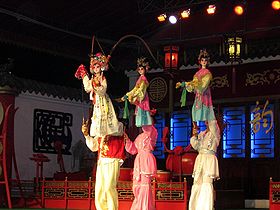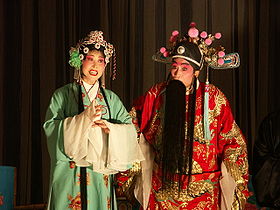
Sichuan opera
Encyclopedia



Chinese opera
Chinese opera is a popular form of drama and musical theatre in China with roots going back as far as the third century CE...
originating in China
China
Chinese civilization may refer to:* China for more general discussion of the country.* Chinese culture* Greater China, the transnational community of ethnic Chinese.* History of China* Sinosphere, the area historically affected by Chinese culture...
's Sichuan
Sichuan
' , known formerly in the West by its postal map spellings of Szechwan or Szechuan is a province in Southwest China with its capital in Chengdu...
province around 1700. Today's Sichuan opera is a relatively recent synthesis of 5 historic melodic styles. Regionally Chengdu
Chengdu
Chengdu , formerly transliterated Chengtu, is the capital of Sichuan province in Southwest China. It holds sub-provincial administrative status...
remains to be the main home of Sichuanese opera, while other influential locales include Chongqing
Chongqing
Chongqing is a major city in Southwest China and one of the five national central cities of China. Administratively, it is one of the PRC's four direct-controlled municipalities , and the only such municipality in inland China.The municipality was created on 14 March 1997, succeeding the...
, Guizhou
Guizhou
' is a province of the People's Republic of China located in the southwestern part of the country. Its provincial capital city is Guiyang.- History :...
, Yunnan
Yunnan
Yunnan is a province of the People's Republic of China, located in the far southwest of the country spanning approximately and with a population of 45.7 million . The capital of the province is Kunming. The province borders Burma, Laos, and Vietnam.Yunnan is situated in a mountainous area, with...
, Hubei
Hubei
' Hupeh) is a province in Central China. The name of the province means "north of the lake", referring to its position north of Lake Dongting...
and Taiwan
Taiwan
Taiwan , also known, especially in the past, as Formosa , is the largest island of the same-named island group of East Asia in the western Pacific Ocean and located off the southeastern coast of mainland China. The island forms over 99% of the current territory of the Republic of China following...
.
History
Initially there were 5 distinct opera styles. The history of each style varies greatly.At least one of the Chinese operatic styles began as early as the Three Kingdoms
Three Kingdoms
The Three Kingdoms period was a period in Chinese history, part of an era of disunity called the "Six Dynasties" following immediately the loss of de facto power of the Han Dynasty rulers. In a strict academic sense it refers to the period between the foundation of the state of Wei in 220 and the...
period with some form of Canjun opera. During the Tang dynasty
Tang Dynasty
The Tang Dynasty was an imperial dynasty of China preceded by the Sui Dynasty and followed by the Five Dynasties and Ten Kingdoms Period. It was founded by the Li family, who seized power during the decline and collapse of the Sui Empire...
, a band of five came about in Chengdu
Chengdu
Chengdu , formerly transliterated Chengtu, is the capital of Sichuan province in Southwest China. It holds sub-provincial administrative status...
. In the Song dynasty
Song Dynasty
The Song Dynasty was a ruling dynasty in China between 960 and 1279; it succeeded the Five Dynasties and Ten Kingdoms Period, and was followed by the Yuan Dynasty. It was the first government in world history to issue banknotes or paper money, and the first Chinese government to establish a...
, the opera developed into zaju. In the Ming dynasty
Ming Dynasty
The Ming Dynasty, also Empire of the Great Ming, was the ruling dynasty of China from 1368 to 1644, following the collapse of the Mongol-led Yuan Dynasty. The Ming, "one of the greatest eras of orderly government and social stability in human history", was the last dynasty in China ruled by ethnic...
, artists performed the skill in Jinling (modern-day Nanjing). During the reign of Yongzheng
Yongzheng Emperor
The Yongzheng Emperor , born Yinzhen , was the fifth emperor of the Manchu Qing Dynasty and the third Qing emperor from 1722 to 1735. A hard-working ruler, Yongzheng's main goal was to create an effective government at minimal expense. Like his father, the Kangxi Emperor, Yongzheng used military...
and Qianlong
Qianlong Emperor
The Qianlong Emperor was the sixth emperor of the Manchu-led Qing Dynasty, and the fourth Qing emperor to rule over China proper. The fourth son of the Yongzheng Emperor, he reigned officially from 11 October 1735 to 8 February 1796...
emperor in the Qing dynasty
Qing Dynasty
The Qing Dynasty was the last dynasty of China, ruling from 1644 to 1912 with a brief, abortive restoration in 1917. It was preceded by the Ming Dynasty and followed by the Republic of China....
, in the Huabu
Chinatown
A Chinatown is an ethnic enclave of overseas Chinese people, although it is often generalized to include various Southeast Asian people. Chinatowns exist throughout the world, including East Asia, Southeast Asia, the Americas, Australasia, and Europe. Binondo's Chinatown located in Manila,...
areas, Kunqu
Kunqu
Kunqu , also known as Kunju , Kun opera or Kunqu Opera, is one of the oldest extant forms of Chinese opera. It evolved from the Kunshan melody, and dominated Chinese theatre from the 16th to the 18th centuries. The style originated in the Wu cultural area...
, Yiyang
Yiyang
Yiyang is a prefecture-level city at the Zi River in Hunan province, China. According to the 2010 Census, Yiyang has a population of 4,313,084 inhabitants residing in an area of 12,144 km². It can be said that the population of the city hasn't changed since the last census in 2000, when the data...
, Bangzi
Bangzi
Jaguar/Sandbox/3 is a township-level division situated in Tangshan, Hebei, China....
and Pihuang melody merged with local languages, folk customs, ditties, yang-kos and Lantern theatre (Dengdiao) in Sichuan.
During the early 20th century, a revival movement began to reform the art. The best known reformer was Kang Zhilin, who led the Sanqinq (Three Celebrations) Company. This company was one of the most notable opera troupes, established in 1912, and combined the 5 styles into a single opera on the same stage. Each style retained its own music. One of the classic skills devised by Kang Zhilin included a high kick that leaves a "third eye" in the middle of the forehead. This has remained one of Sichuanese opera's trademark moves.
During the Cultural Revolution
Cultural Revolution
The Great Proletarian Cultural Revolution, commonly known as the Cultural Revolution , was a socio-political movement that took place in the People's Republic of China from 1966 through 1976...
, the art form suffered somewhat. But it continued to flourish afterwards, especially since the 1978 Chinese economic reform.
Performance
Overall the art form is well known for its singing, which is less constrained than that of the more popular Beijing operaBeijing opera
Peking opera or Beijing opera is a form of traditional Chinese theatre which combines music, vocal performance, mime, dance and acrobatics. It arose in the late 18th century and became fully developed and recognized by the mid-19th century. The form was extremely popular in the Qing Dynasty court...
form. Sichuan opera is more like a play than other forms of Chinese opera, and the acting is highly polished. The music accompanying Sichuanese opera utilizes a small gong and an instrument called a Muqin, which is similar to the Erhu
Erhu
The erhu is a two-stringed bowed musical instrument, more specifically a spike fiddle, which may also be called a "southern fiddle", and sometimes known in the Western world as the "Chinese violin" or a "Chinese two-stringed fiddle". It is used as a solo instrument as well as in small ensembles...
.
The traditional formula is quite systematic with a combination of stunts like face-changing
Bian Lian
Bian Lian is an ancient Chinese dramatic art that is part of the more general Sichuan opera. Performers wear brightly colored costumes and move to quick, dramatic music. They also wear vividly colored masks, which they change within a fraction of a second....
, tihuiyan, sword-hiding, fire-spitting and beard-changing with the plot and different characters.
5 styles
- Gaoqiang (高/高)
- KunqiangKunquKunqu , also known as Kunju , Kun opera or Kunqu Opera, is one of the oldest extant forms of Chinese opera. It evolved from the Kunshan melody, and dominated Chinese theatre from the 16th to the 18th centuries. The style originated in the Wu cultural area...
(崑/昆) - Huqing voice (鬍/胡)
- Tanxi (彈/彈)
- Dengdiao / Dengxi / Lantern theatre (燈/灯)

